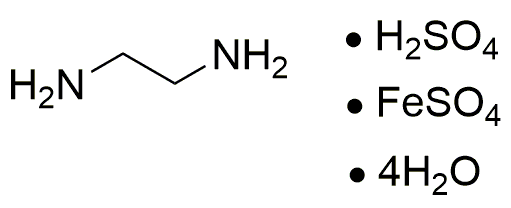Iron(II) ethylenediammonium sulfate tetrahydrate is widely utilized in research focused on:
- Analytical Chemistry: This compound serves as a reagent in various analytical techniques, helping researchers determine the presence of other substances through complexation reactions.
- Biochemistry: It is used in cell culture media to provide essential iron, promoting healthy cell growth and functioning, particularly in studies involving iron metabolism.
- Material Science: The compound is employed in the synthesis of magnetic nanoparticles, which are valuable in drug delivery systems and targeted therapies.
- Environmental Science: It plays a role in the treatment of wastewater, where it helps in the removal of contaminants through precipitation processes.
- Pharmaceuticals: This compound is explored for its potential in developing iron supplements, addressing iron deficiency anemia with improved bioavailability compared to traditional forms.
General Information
Properties
Safety and Regulations
Applications
Iron(II) ethylenediammonium sulfate tetrahydrate is widely utilized in research focused on:
- Analytical Chemistry: This compound serves as a reagent in various analytical techniques, helping researchers determine the presence of other substances through complexation reactions.
- Biochemistry: It is used in cell culture media to provide essential iron, promoting healthy cell growth and functioning, particularly in studies involving iron metabolism.
- Material Science: The compound is employed in the synthesis of magnetic nanoparticles, which are valuable in drug delivery systems and targeted therapies.
- Environmental Science: It plays a role in the treatment of wastewater, where it helps in the removal of contaminants through precipitation processes.
- Pharmaceuticals: This compound is explored for its potential in developing iron supplements, addressing iron deficiency anemia with improved bioavailability compared to traditional forms.
Documents
Safety Data Sheets (SDS)
The SDS provides comprehensive safety information on handling, storage, and disposal of the product.
Product Specification (PS)
The PS provides a comprehensive breakdown of the product’s properties, including chemical composition, physical state, purity, and storage requirements. It also details acceptable quality ranges and the product's intended applications.
Certificates of Analysis (COA)
Search for Certificates of Analysis (COA) by entering the products Lot Number. Lot and Batch Numbers can be found on a product’s label following the words ‘Lot’ or ‘Batch’.
Numéro de catalogue
Numéro de lot/série
Certificates Of Origin (COO)
This COO confirms the country where the product was manufactured, and also details the materials and components used in it and whether it is derived from natural, synthetic, or other specific sources. This certificate may be required for customs, trade, and regulatory compliance.
Numéro de catalogue
Numéro de lot/série
Safety Data Sheets (SDS)
The SDS provides comprehensive safety information on handling, storage, and disposal of the product.
DownloadProduct Specification (PS)
The PS provides a comprehensive breakdown of the product’s properties, including chemical composition, physical state, purity, and storage requirements. It also details acceptable quality ranges and the product's intended applications.
DownloadCertificates of Analysis (COA)
Search for Certificates of Analysis (COA) by entering the products Lot Number. Lot and Batch Numbers can be found on a product’s label following the words ‘Lot’ or ‘Batch’.
Numéro de catalogue
Numéro de lot/série
Certificates Of Origin (COO)
This COO confirms the country where the product was manufactured, and also details the materials and components used in it and whether it is derived from natural, synthetic, or other specific sources. This certificate may be required for customs, trade, and regulatory compliance.

